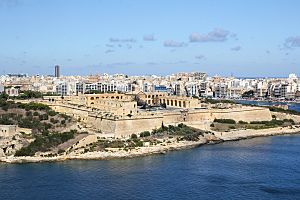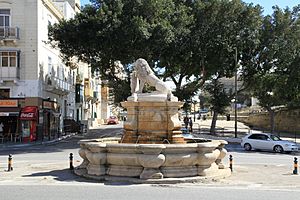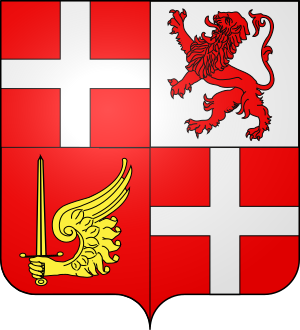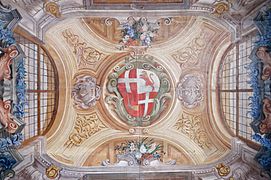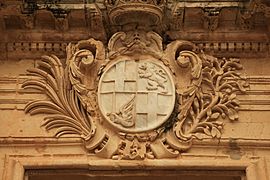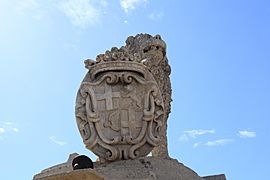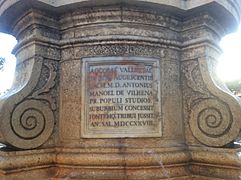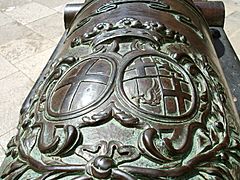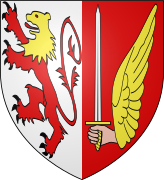António Manoel de Vilhena facts for kids
Quick facts for kids
António Manoel de Vilhena
|
|
|---|---|

Painting of Grand Master de Vilhena
|
|
| Grand Master of the Order of Saint John | |
| In office 19 June 1722 – 10 December 1736 |
|
| Preceded by | Marc'Antonio Zondadari |
| Succeeded by | Ramon Despuig |
| Personal details | |
| Born | 28 May 1663 Lisbon, Kingdom of Portugal |
| Died | 10 December 1736 (aged 73) Malta |
| Resting place | St. John's Co-Cathedral |
| Military service | |
| Allegiance | |
António Manoel de Vilhena (born May 28, 1663 – died December 10, 1736) was a Portuguese nobleman. He became the 66th Grand Master of the Order of St. John of Jerusalem. He led the Order from June 19, 1722, until his death in 1736. Unlike some other Grand Masters, he was kind and well-liked by the people of Malta. Vilhena is best remembered for starting the town of Floriana, building Fort Manoel and the Manoel Theatre, and making the city of Mdina new again.
Contents
Early Life of António Manoel de Vilhena
António Manoel de Vilhena was born in Lisbon, Portugal, on May 28, 1663. His father, Dom Sancho Manoel de Vilhena, was an important general. His father fought in wars across Europe and in Brazil.
Grand Master's Rule
De Vilhena was chosen as Grand Master on June 19, 1722. This was just three days after the previous Grand Master passed away.
Making Mdina New Again
On September 20, 1722, Vilhena visited the ancient city of Mdina. He was very impressed by the warm welcome he received. Because of this, he ordered the city's walls and buildings to be repaired and updated. A French architect named Charles François de Mondion was put in charge. He designed many beautiful Baroque buildings for the city. Some of these buildings include the Mdina Gate, the Torre dello Standardo, Palazzo Vilhena, the Banca Giuratale, and the Corte Capitanale.
Building Fort Manoel
In 1723, Vilhena paid for the building of Fort Manoel. This fort was built on a small island, now called Manoel Island, in Marsamxett Harbour. The fort took ten years to finish and was used until the 20th century. Its chapel was named after St. Anthony of Padua, Vilhena's favorite saint. Vilhena also created a special fund to keep the fort running and guarded. A bronze statue of the Grand Master was placed in the fort's main square in 1736. It was later moved to Floriana.
Improving Malta's Defenses
Besides Fort Manoel and the Mdina walls, many other improvements were made to Malta's defenses during Vilhena's time. Saint Anthony's Battery was built on Gozo. The fortifications of Birgu were made stronger. Work also continued on the unfinished Cottonera Lines. In 1736, the Santa Margherita Lines were finally completed.
Founding Floriana
In 1724, the Grand Master started a new town called Borgo Vilhena. This was to help with the need for more homes near the capital city of Valletta. This new town is now known as Floriana. It still uses symbols from Vilhena's family crest in its own emblem today.
Other Buildings and Projects
In 1730, Vilhena built a summer home called Palazzo Manoel in Santa Venera. It is now known as Casa Leoni. He also built a hunting lodge in Naxxar in 1733, which later became Palazzo Parisio. Vilhena also made the old Verdala Palace in Buskett more beautiful.
Vilhena also ordered the building of the Teatro Pubblico (Public Theatre) in Valletta in 1731. It opened a year later and was later renamed the Manoel Theatre. It is still used today, making it one of the oldest working theatres in Europe. Another public building from his time is the Banca Giuratale of Gozo, built in 1733.
Peace and Neutrality
During Vilhena's rule, there was an attempt to make peace between the Order and the Ottoman Empire. However, no peace agreement was reached. Vilhena also kept the Order neutral when the War of the Polish Succession started in 1733. This meant Malta did not take sides in the conflict.
Death
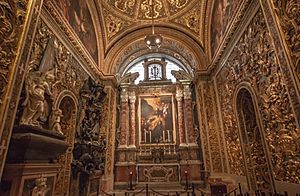
Vilhena died on December 10, 1736, at 73 years old. Ramon Despuig became the next Grand Master. Vilhena was buried in the Chapel of the Langue of Castile, Leon and Portugal. This chapel is inside the main church of the Order, now called St. John's Co-Cathedral. His tomb was designed by a famous sculptor named Massimiliano Soldani Benzi.
Some people say that Fort Manoel is haunted by a ghost known as the Black Knight, who looks like de Vilhena.
Heraldry
Vilhena's coat of arms shows a lion and a winged arm holding a sword. These symbols represent his family. They are combined with a white cross on a red background, which stands for the Order of St. John.
You can see the Grand Master's coat of arms on many buildings he had built. These include Fort Manoel and Palazzo Vilhena.
Parts of his coat of arms are still used today in the coat of arms of Floriana:
See also
 In Spanish: António Manoel de Vilhena para niños
In Spanish: António Manoel de Vilhena para niños


